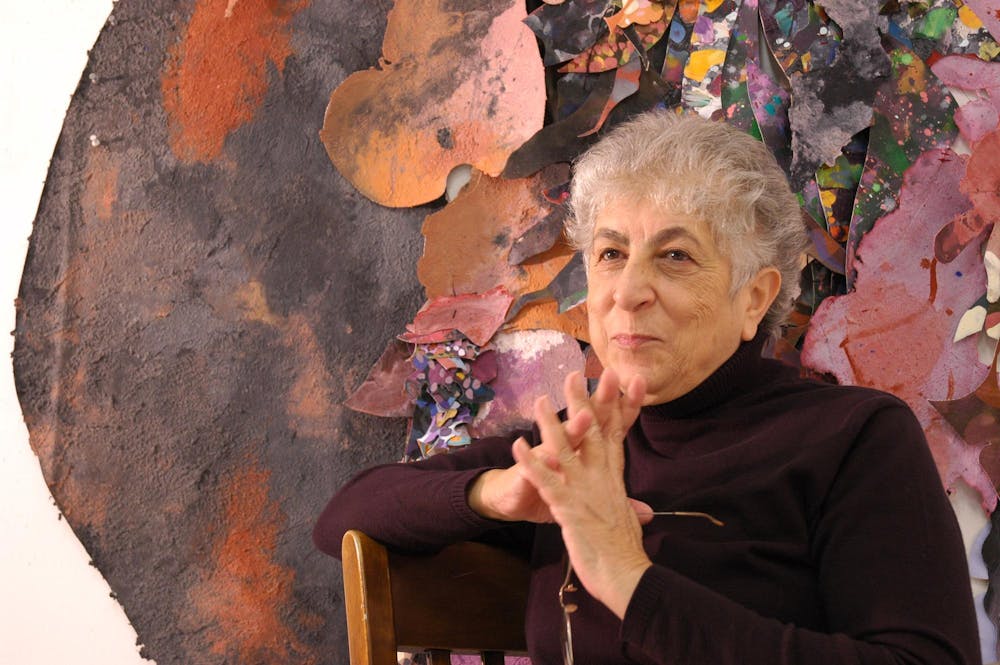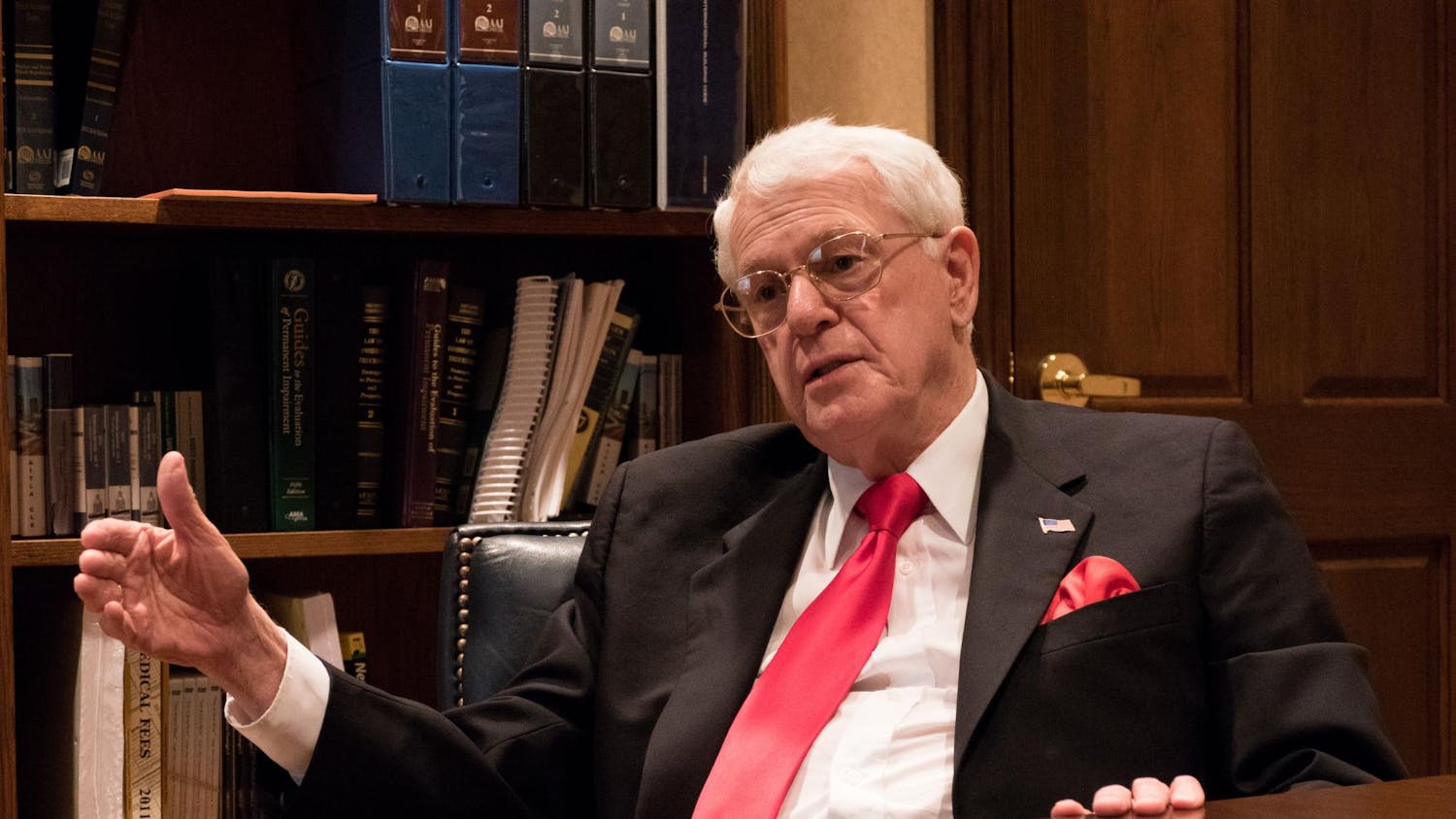A week after Palestinian artist Samia Halaby’s exhibition was supposed to open at the Eskenazi Museum of Art, members of the Bloomington community flocked in the Buskirk-Chumley Theater to see the sold-out show, “Samia Halaby Uncanceled.”
Aided by the Bloomington chapter of the American Association of University Professors, IU professor Elizabeth Housworth organized the event, which includes a series of videos documenting Halaby’s art and life.
IU canceled Halaby’s abstract art exhibition Dec. 20, citing security concerns and Halaby’s pro-Palestinian social media posts. In an address to the Bloomington Faculty Council, Provost Rahul Shrivastav explained Halaby’s art, if allowed to open as planned in February, would be a “potential lightning rod” in a charged campus climate influenced by the ongoing Israel-Hamas war.
Though the show had been planned for three years, IU did not respond to Halaby’s repeated emails to the administration after she was informed of the cancelation nor provide examples of specific threats.
The decision has been condemned by many IU faculty members and students, including Eskenazi School staff. It has made waves internationally, gathering condemnation from groups like the International Committee for Museums and Collections of Modern Art Museum Watch and PEN America.
Housworth began the event by thanking the AAUP for sponsoring it and reading a message from Halaby’s grandniece, Madison Gordon. In the message Housworth read, Gordon encouraged the crowd to find joy and wonder in Halaby’s art.
“Ceasefire now. Free Palestine,” Gordon wrote at the end of her message.
The first video played was a home video Gordon filmed of Halaby explaining her kinetic art made using a Commodore Amiga 1000, a computer released in 1985.
As she explained her process, glittering lines wrapped around the screen, becoming amorphous shapes that stretched across the screen like watercolors on paper. As the shapes moved, they began to form pairs of women. Calling herself impatient, Halaby clicked through the commands, cycling the painting through its phases. More glittering shapes of women appeared, layering the screen until it was a crowd of women — all shouting, Halaby narrated, until the “Big Mama” appeared in a white dress.
Halaby joked with her grandniece in the video as she showed her the art, laughing as the camera tilts between the computer screen and Halaby herself.
The next video was a short documentary created by Bill Winters, who said he was fascinated by Halaby and the art she made through the Commodore Amiga. In a filmed introduction, Winters said the Amiga was the first home computer to provide multimedia capabilities, a mind-blowing piece of technology at the time.
Calling himself a firm believer in free speech, Winters said he wished the exhibition at IU would be reinstated.
“I truly hope that the university comes to their senses,” he said in the video.
In the documentary, Halaby again describes her kinetic artwork. She said logic is part of her creative process, narrating how her commands instruct the colors to rise until they hit an upper bound before cascading down again. She calls it a yo-yo, a reference to the effect the command generates across the screen.
In the next video, Halaby describes some of her abstract paintings in an art discussion at the Guggenheim Museum.
There is “Jerusalem, My Home,” which depicts the Dome of the Rock — the oldest Islamic monument still standing — as an orange ball specked with periwinkle and set against a blue sky. Then there is “Palestine, from the Mediterranean Sea to the Jordan River,” a colorful collection of painted canvas and paper strips that is supposed to be a map of the land.
Another painting celebrates the American Midwest. “Big Oak, Homage to the Shawnee,” is another project of stitched canvas strips inspired by oak trees Halaby saw when driving one day in Indiana. She decided to dedicate the painting to the Shawnee that had occupied the land before European colonization.
In between discussions of her art in the art discussion video, Halaby spoke about her life. She showed photos of herself as a young girl and told a story about how Israeli soldiers once looted her town, taking her family’s books, paintings and valuables while the rest of their belongings ended up in a Tel Aviv flea market.
She also showed photos of her when she attended IU, joking that it took some time to “free” herself from academia and drawing laughs from the crowd at the theater.
While the event was mainly informative, there was an undercurrent of protest.
Representatives from the Green Feather Movement, who launched their homage to IU students who protested McCarthyism in 1953 last week at Showalter Fountain, handed out flyers and feathers at the door while a table for the AAUP urged people to join the organization to fight back against bills “targeting” higher education across the country — a reference to Indiana’s Senate Bill 202 and similar legislation. According to a representative from the AAUP, graduate students with academic appointments can also join the AAUP.
During intermission, some audience members shared their dissatisfaction with the IU administration. Carl Pearson, associate director of the Center for the Study of the Middle East, held a cloth sign that read “Whitten Must Resign.”
When the event began again after intermission, Faisal Saleh, founder and executive director of the Palestine Museum US, spoke in person to introduce the “life” portion of the event.
When Saleh began developing the museum, he said there were no Palestinian museums in the Western hemisphere, while there were at least 70 museums promoting the “Israeli narrative.” Saleh emphasized the humanity of Palestinians, rebuking an Israeli defense minister’s comment that Israel was fighting “human animals” while announcing a siege on Gaza shortly after Hamas’ Oct. 7 attack.
“We’re not human animals, like some of our enemies are trying to portray us as,” Saleh said.
He then read a statement from Halaby, who wrote she was moved by the energy of those at IU who have become politically active regarding free speech and Palestine, both for her and for suspended professor Abdulkader Sinno. She criticized the IU administration for disregarding the “collective will” in favor of “those who rule above.”




